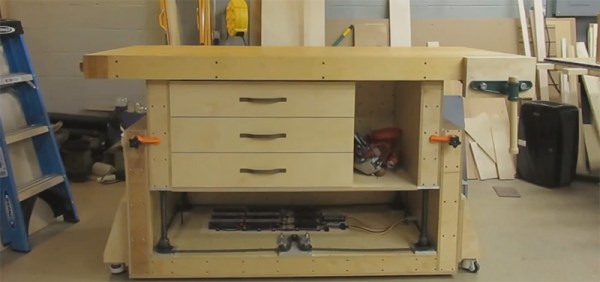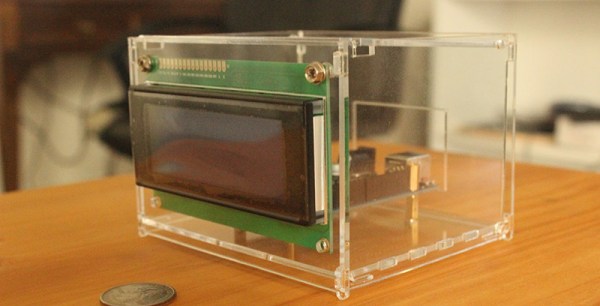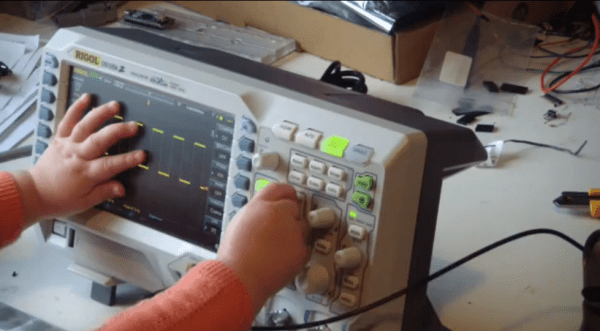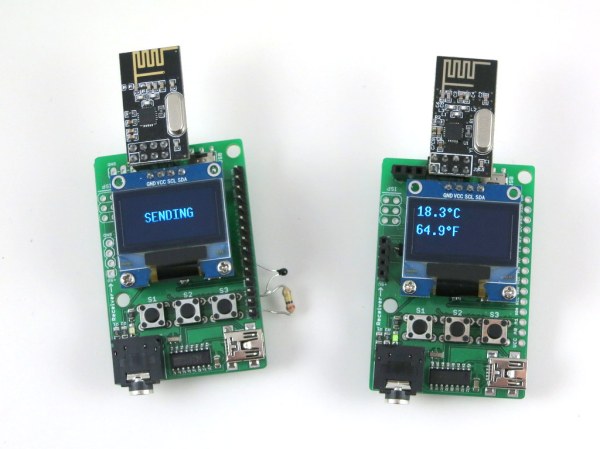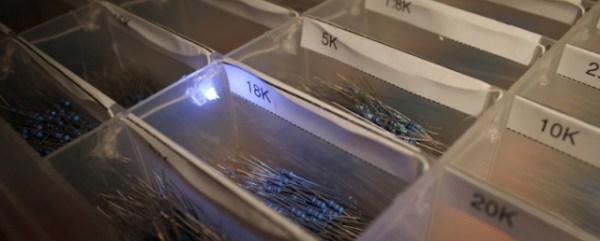This is a post about workbenches, but not the benches you’re probably thinking about. Workbenches meant for electronics development are simple matters – just about any flat surface, a few shelves for equipment, and an anti-static mat will be fine for every conceivable use. Workbenches for woodworking are a separate matter entirely. There’s actually quite a bit of history behind the development of the woodworking workbench, but the basic idea is a thick laminated wood top, integrated vices, holes in the work surface for bench dogs, and ergonomics that allow for comfortable use of hand tools. The basic design of these benches hasn’t changed much in several hundred years, and [Dirk] thought the design was ready for a modern update.
Tool Hacks3033 Articles
Upgrading A Laminator For Toner Transfer PCBs
If you need a circuit board now, you’re probably looking at a toner transfer process; all you need to make a PCB is a copper clad board, a laser printer, some special paper, and the usual etching chemicals. The quality of these boards is highly dependant on the quality of transferring toner to the copper, and getting the process right is as much an art as it is a science. A clothes iron is the easy way of transferring the toner to the board, but if you’re looking for repeatability, you’ll probably want a laminator.
Laminators, too, also vary in quality. The king of toner transfer laminators is the Apache AL13P. With four heated rollers and a steel chassis, it’s enough to do some serious heating. [mosaicmerc] came up with an amazing mod for his Apache laminator that takes all the guesswork out of the settings, and does it all in one pass for maximum repeatability and PCB quality.
The Apache laminator in question is a beast of a machine that drives four rollers with a synchronous motor and also has a ‘reverse’ button that sends the laminations out the front end of the printer. Stock, a toner transfer PCB would require dozens of passes through the Apache, but [merc]’s mod takes care of everything for you.
The addition that makes this possible is a small board with a PIC12 microcontroller. This microcontroller connects the motor driver board and the display interface together, triggering the reverse button to move the board 5/8″ forward and 1/2″ back, giving the laminator an effective speed reduction of 12:1. This method also has the bonus of not tampering with the motor or control circuitry, and allows for multiple passes in the same run.
With this modification, the Apache AL13P becomes the perfect solution to transferring toner to a piece of copper, with the ability to transfer 10mil traces on 1oz copper. The board also offers some other features like thermal sensor failure shutdown and a cool-down mode that overrides the heater. If you’re looking for an easy way to step up your toner transfer PCBs, you can’t do much better than this mod.
Automated CAD Design For Enclosures
[Jon] a.k.a. [Pedantite] recently added small-scale laser cutting to his business and thought about using that laser cutter to add some value to some of the many project designs he creates. Yes, this means custom laser cut enclosures, but how to go about it? [Jon] loves automation, and that can only mean automated design of laser cut enclosures by reading the board files from his project library.
The idea of automating the design of plastic enclosures was to read the design files, figure out the dimensions of the board and where the mounting holes go, and generate a file for the laser cutter. The weapon of choice was OpenSCAD, a design language that can be highly parameterized, read external design files, and spit out proper DXF files for laser cutting.
[Jon] set up his toolchain as a Python script that reads design files, sends parameters off to a .SCAD file, and generates a DXF for the laser cutter. There’s also a bit that generates enough data for Blender to render a 3D image of the finished product, all only from gerbers, a drill file, and a few user variables.
The source for these files haven’t been released yet, but that’s only because it’s in a proof-of-concept stage right now. You can check out an example of a render of one of the cases below.
RTL SDR As A Spectrum Analyzer
RTL-SDR, the USB TV tuner turned software-defined radio is an amazing device, capable of listening to nearly anything from 25MHz to 1750MHz, fits in your pocket, and costs about $20. Even more astonishing is that it’s also a kinda-okay spectrum analyzer. [Kerry D. Wong] tested out one of these USB TV tuner, and the results are exactly what you would expect: it lacks a little precision, and sampling bandwidth is only a tiny bit terrible, but it does work.
A stock USB TV tuner doesn’t come with a connector that would normally be used for spectrum analysis. A BNC connector can be easily attached, as can a terminator to match the 75Ω impedance of the SDR. This isn’t really necessary; the frequencies being measured are low enough that you can get away without one.
As far as software goes, [Kerry] first pulled out the usual suspects of the SDR world; rtlsdr-scanner distorted the measured spectrum, as did a lot of other SDR receivers. Gqrx SDR was the first one that worked well, but the king of this repurposing of USB TV tuners was OSMOCOM. There’s a huge number of tools for spectrum analysis right out of the box with this package.
How did the RTL SDR fare as a spectrum analyzer? Feeding some stuff in from a signal generator, [Kerry] discovered the LO in the RTL SDR was off by a hair. Also, OSMOCOM only measures amplitude in dB, not the dBm found in every other spectrum analyzer ever made. By measuring a 0 dBm signal whatever value displayed can be shifted up or down.
So, does it work? Yes, it does. If, for some reason, you need a spectrum analyzer now, can you use this? Yep. Pretty cool.
How To Get 50 More Zed From Your Rigol DS1054Z
[Chris] has been spending a lot of time in the wife’s sewing room lately, and things got pretty serious late last night as he hacked his shiny new Rigol DS1054Z to unlock the 1104Z capabilities lurking within.
The rumors are true, and ungoverning the software is as simple as looking up your serial number and knowing the right URL for generating a valid license. [Chris] ran into a dud site, but that’s the price of doing business in the shadowy parking garage basements of the interwebs. Once he knocked on the right door and uttered the secret word, however, he became the proud owner of 50MHz additional bandwidth, decoders for SPI, I²C, and RS-232, twice the storage depth, and all teh triggers that ship with the 1104Z.
Can’t rationalize the purchase even at the ridiculously low price point? Here’s one way to make it happen. You’ll laugh, you’ll cry, you’ll learn some French.
Continue reading “How To Get 50 More Zed From Your Rigol DS1054Z”
RFToy Makes Wireless Projects Easier
[Ray] has created RFToy, a simple gadget to aid in setting up wireless systems with a variety of common radio modules. RFToy is an open source microcontroller board running on an ATmega328. While RFToy is Arduino code compatible, [Ray] chose to ditch the familiar Arduino shield layout for one that makes it easier to install RF modules, and is more handheld friendly.
[RFToy] includes headers for the popular nRF24L01 2.4 GHz transceiver, as well as 433/315 transmitters and receivers found in many low-cost wireless electronic devices. The 128×64 pixel OLED screen and 3 button interface make it easy to set up simple user interfaces for testing new designs.
[Ray] hasn’t broken any new ground here. What he has done is create a simple tool for wireless projects. Anyone who’s worked on a wireless system can tell you that tools like this are invaluable for debugging why your circuit isn’t talking. Is it the transmitter? The receiver? Something else in the power supply circuit?
Check out [Ray’s] demo video after the break. In it, he sniffs, records, and plays back signals from several remote-controlled outlets. [Ray] also has a great demo of sending temperature data back and forth using an nRF24L01.
Light Up Component Bins And A Manual Pick And Place
[Mike] makes some very niche musical instruments, and the production volume he’s looking at means there isn’t a need to farm out his assembly. This means doing everything by hand, including the annoying task of picking resistors and other components out of bins. After searching for a way to speed up his assembly process, he came up with the Stuffomatic, a device that locates the correct component at the press of a button.
The normal way of grabbing a part when assembling is reading the reference on the board, cross referencing the value on the BOM, and digging the correct part out of the bin. To speed this up, [Mike] put LEDs in each of the part bins, connected to a Teensy 2.0 that has the BOM stored in memory. Clicking a foot switch looks up the next component and lights up the LED in the associated part bin.
[Mike] says this invention has speeded up his assembly time by about 30%, a significant amount if you’re looking at hours to assemble one unit.
If you’re wondering exactly what [Mike] is assembling, check this out. It’s heavily inspired by the Ondes Martenot, an electronic musical instrument that’s about as old as the theremin, but a million times cooler. Video sample below.
Continue reading “Light Up Component Bins And A Manual Pick And Place”

